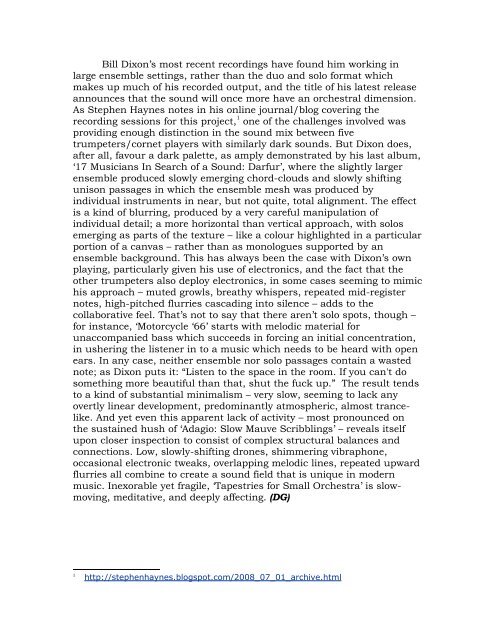Download it Here - Eartrip Magazine
Download it Here - Eartrip Magazine
Download it Here - Eartrip Magazine
Create successful ePaper yourself
Turn your PDF publications into a flip-book with our unique Google optimized e-Paper software.
Bill Dixon’s most recent recordings have found him working in<br />
large ensemble settings, rather than the duo and solo format which<br />
makes up much of his recorded output, and the t<strong>it</strong>le of his latest release<br />
announces that the sound will once more have an orchestral dimension.<br />
As Stephen Haynes notes in his online journal/blog covering the<br />
recording sessions for this project, 1 one of the challenges involved was<br />
providing enough distinction in the sound mix between five<br />
trumpeters/cornet players w<strong>it</strong>h similarly dark sounds. But Dixon does,<br />
after all, favour a dark palette, as amply demonstrated by his last album,<br />
‘17 Musicians In Search of a Sound: Darfur’, where the slightly larger<br />
ensemble produced slowly emerging chord-clouds and slowly shifting<br />
unison passages in which the ensemble mesh was produced by<br />
individual instruments in near, but not qu<strong>it</strong>e, total alignment. The effect<br />
is a kind of blurring, produced by a very careful manipulation of<br />
individual detail; a more horizontal than vertical approach, w<strong>it</strong>h solos<br />
emerging as parts of the texture – like a colour highlighted in a particular<br />
portion of a canvas – rather than as monologues supported by an<br />
ensemble background. This has always been the case w<strong>it</strong>h Dixon’s own<br />
playing, particularly given his use of electronics, and the fact that the<br />
other trumpeters also deploy electronics, in some cases seeming to mimic<br />
his approach – muted growls, breathy whispers, repeated mid-register<br />
notes, high-p<strong>it</strong>ched flurries cascading into silence – adds to the<br />
collaborative feel. That’s not to say that there aren’t solo spots, though –<br />
for instance, ‘Motorcycle ‘66’ starts w<strong>it</strong>h melodic material for<br />
unaccompanied bass which succeeds in forcing an in<strong>it</strong>ial concentration,<br />
in ushering the listener in to a music which needs to be heard w<strong>it</strong>h open<br />
ears. In any case, ne<strong>it</strong>her ensemble nor solo passages contain a wasted<br />
note; as Dixon puts <strong>it</strong>: “Listen to the space in the room. If you can't do<br />
something more beautiful than that, shut the fuck up.” The result tends<br />
to a kind of substantial minimalism – very slow, seeming to lack any<br />
overtly linear development, predominantly atmospheric, almost trancelike.<br />
And yet even this apparent lack of activ<strong>it</strong>y – most pronounced on<br />
the sustained hush of ‘Adagio: Slow Mauve Scribblings’ – reveals <strong>it</strong>self<br />
upon closer inspection to consist of complex structural balances and<br />
connections. Low, slowly-shifting drones, shimmering vibraphone,<br />
occasional electronic tweaks, overlapping melodic lines, repeated upward<br />
flurries all combine to create a sound field that is unique in modern<br />
music. Inexorable yet fragile, ‘Tapestries for Small Orchestra’ is slowmoving,<br />
med<strong>it</strong>ative, and deeply affecting. (DG)<br />
1 http://stephenhaynes.blogspot.com/2008_07_01_archive.html


